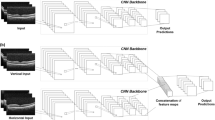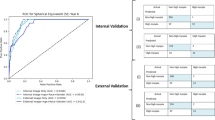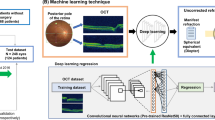Abstract
To develop an approach of combining convolution neural network and graph convolution network to predict the progression of myopia. The working distance (WD) and light intensity (LI) of three hundred and seventeen children were recorded by Clouclip. The spherical equivalent refraction (SER) of the children were recorded by ophthalmologists. The data of WD and LI were filtered and mapped into a two-dimensional WD-LI space. The percentage of time (PoT) falling into each pixel in the space was calculated for each subject. The space of each subject can be thought of as an image and it is the input of our neural network model that combining several convolution layers and graph convolution layers. The output of the model is the SER. With tenfold cross validation, the validation error is 0.79 D when the L1 loss function is used. This study provides an innovative way to predict the development of myopia by WD and LI. The convolution neural network and graph convolution network are used to predict the myopia with WD and LI simultaneously, which has not been done before.






Similar content being viewed by others
Explore related subjects
Discover the latest articles, news and stories from top researchers in related subjects.References
Morgan IG, Onho-Matsui K, Saw SM (2012) Myopia. Lancet 379(9827):1739–1748
Saw SM, Chua WH, Hong CY et al (2002) Nearwork in early-onset myopia. Invest Ophthalmol Vis Sci 43(2):332–339
Ip JM, Saw SM, Rose KA et al (2008) Role of near work in myopia: findings in a sample of Australian school children. Invest Ophthalmol Vis Sci 49(7):2903–2910
Mutti DO, Mitchell GL, Moeschberger ML et al (2002) Parental myopia, near work, school achievement, and children’s refractive error. Invest Ophthalmol Vis Sci 43(12):3633–3640
Rose KA, Morgan IG, Ip J et al (2008) Outdoor activity reduces the prevalence of myopia in children. Ophthalmology 115(8):1279–1285
Rose KA, Morgan IG, Smith W et al (2008) Myopia, lifestyle, and schooling in students of Chinese ethnicity in Singapore and Sydney. Arch Ophthalmol 126(4):527–530
McCarthy CS, Megaw P, Devadas M et al (2007) Dopaminergic agents affect the ability of brief periods of normal vision to prevent form-deprivation myopia. Exp Eye Res 84(1):100–107
Ester M, Kriegel HP, Sander J (1997) Spatial data mining: a database approach. In: International symposium on spatial databases. Springer, Berlin, Heidelberg, pp. 47–66
Yang T, Gong YS (2008) Spatial data mining features between general data mining. In: 2008 International workshop on education technology and training & 2008 international workshop on geoscience and remote sensing. IEEE 2:541–544
Lo SCB, Chan HP, Lin JS et al (1995) Artificial convolution neural network for medical image pattern recognition. Neural Netw 8(7–8):1201–1214
Traore BB, Kamsu-Foguem B, Tangara F (2018) Deep convolution neural network for image recognition. Eco Inform 48:257–268
Liu T, Fang S, Zhao Y, et al. (2015) Implementation of training convolutional neural networks. arXiv preprint arXiv:1506.01195
Mishkin D, Sergievskiy N, Matas J (2017) Systematic evaluation of convolution neural network advances on the imagenet. Comput Vis Image Underst 161:11–19
Cui P, Wang X, Pei J et al (2018) A survey on network embedding. IEEE Trans Knowl Data Eng 31(5):833–852
Bacciu D, Errica F, Micheli A et al (2020) A gentle introduction to deep learning for graphs. Neural Netw 129:203–221
Wu Z, Pan S, Chen F et al (2020) A comprehensive survey on graph neural networks. IEEE Trans Neural Netw Learn Syst 32(1):4–24
Kipf TN, Welling M (2016) Semi-supervised classification with graph convolutional networks. arXiv preprint arXiv:1609.02907
Schlichtkrull M, Kipf TN, Bloem P, et al. (2018) Modeling relational data with graph convolutional networks. Eur Semant Web Conf. Springer, Cham, pp. 593–607
Li Q, Han Z, Wu XM (2018) Deeper insights into graph convolutional networks for semi-supervised learning. In: Proceedings of the AAAI conference on artificial intelligence. 32(1)
Wen L, Cao Y, Cheng Q et al (2020) Objectively measured near work, outdoor exposure and myopia in children. Br J Ophthalmol 104(11):1542–1547
Wen L, Cheng Q, Lan W et al (2019) An objective comparison of light intensity and near-visual tasks between rural and urban school children in China by a wearable device Clouclip. Transl Vis Sci Technol 8(6):15–15
Li L, Zhu H, Wen L et al (2019) Association of myopia progression with visual behavior. Invest Ophthalmol Vis Sci 60(9):6454–6454
Li L, Zhu H, Wen L et al (2018) An objective environmental risk factor index related to the development of myopia. Invest Ophthalmol Vis Sci 59(9):3394–3394
Li L, Wen L, Lan W et al (2020) A novel approach to quantify environmental risk factors of myopia: combination of wearable devices and big data science. Transl Vis Sci Technol 9(13):17–17
Li J, Liu X, Xiao J, et al. (2019) Dynamic spatio-temporal feature learning via graph convolution in 3D convolutional networks. In: 2019 International conference on data mining workshops (ICDMW). IEEE Computer Society, pp. 646–652.
Acknowledgements
The authors acknowledge the National Nature Science Foundation of China (No. 61702027), the grant of Hunan provincial Science and Technology Innovation Program (No. 2019SK2051), and the grants from Aier Eye Hospital Group (No. AR1903D3).
Author information
Authors and Affiliations
Corresponding authors
Additional information
Publisher's Note
Springer Nature remains neutral with regard to jurisdictional claims in published maps and institutional affiliations.
Rights and permissions
About this article
Cite this article
Li, L., Zhu, H., Wen, L. et al. An Approach of Combining Convolution Neural Network and Graph Convolution Network to Predict the Progression of Myopia. Neural Process Lett 55, 247–257 (2023). https://doi.org/10.1007/s11063-021-10576-w
Accepted:
Published:
Issue Date:
DOI: https://doi.org/10.1007/s11063-021-10576-w




